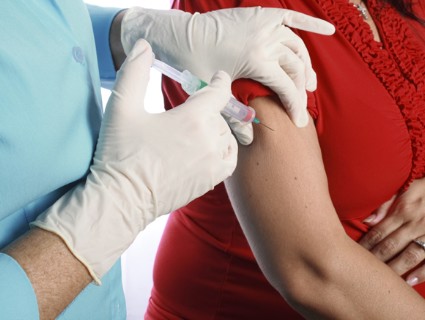User login
SAN FRANCISCO – Influenza vaccination during pregnancy was associated with significantly lower odds of delivering a preterm or small for gestational age infant during a period of widespread influenza activity, but the effects varied based on maternal characteristics, according to findings from a large retrospective cohort study.
A highly significant overall association was seen between maternal vaccination with trivalent inactivated influenza vaccine and reduced odds of preterm birth among all 8,393 women with live births between Jan. 1, 2005, and Dec. 31, 2008, who were included in the study (odds ratio, 0.39). However, vaccination was most protective against preterm birth among white women (OR, 0.34) and women of higher socioeconomic status (OR, 0.30), Dr. Saad Omer of Emory University, Atlanta, reported an annual scientific meeting on infectious diseases.
Vaccination protected against small for gestational age birth only among those at higher risk for influenza-related morbidity, including those enrolled in the WIC (Women, Infant, and Children) program (OR, 0.20) and black women (OR, 0.15), Dr. Omer said at the combined annual meetings of the Infectious Diseases Society of America, the Society for Healthcare Epidemiology of America, the HIV Medicine Association, and the Pediatric Infectious Diseases Society.
Data for this study were derived from the Georgia pregnancy risk assessment and monitoring system, as well as from hospital discharges and birth certificates. A number of prior studies have demonstrated beneficial effects of maternal immunization on maternal outcomes, and a 2011 study by Dr. Omer was the first to demonstrate overall beneficial effects on fetal outcomes following maternal influenza vaccine.
In that study, maternal vaccination was associated with reduced odds of preterm birth during local, regional, and widespread periods of influenza activity (OR, 0.44, 0.41, and 0.28, respectively), and with reduced odds of delivering a small for gestational age infant during the widespread activity period (OR, 0.31), he said (PLoS Med. 2011;8:e1000441). These findings have been replicated in subsequent studies.
But this is a complex process, and there is increasing recognition that inflammation and other factors play a role in preterm birth, he explained, noting: "There is substantial epidemiological and biological evidence that maternal characteristics are associated with adverse birth outcomes."
The current study is the first to look at fetal outcomes stratified by some of these maternal characteristics, he noted.
The outcomes were similar in magnitude to those in his 2011 study – but were restricted to the period of widespread influenza activity.
"And essentially, we had restriction of effect by race," he added, noting that there also was heterogeneity among the two outcomes (preterm birth and small for gestational age birth).
"So the bottom line is, yes, we saw – especially during the period of widespread influenza activity – that there was reduction of odds in both preterm birth and small for gestational age, but there’s more to this story. There is heterogeneity, perhaps based on underlying risk factors and mechanisms through which these extraneous factors have an impact on birth outcome," he said.
Currently, three international trials looking at some of these outcomes are underway, he said, adding: One hopes that from these trials "we’ll have a little bit more clarity both in terms of the actual clinical effect of these interventions, but also in terms of biologic pathways that are involved."
Dr. Omer reported having no disclosures.
SAN FRANCISCO – Influenza vaccination during pregnancy was associated with significantly lower odds of delivering a preterm or small for gestational age infant during a period of widespread influenza activity, but the effects varied based on maternal characteristics, according to findings from a large retrospective cohort study.
A highly significant overall association was seen between maternal vaccination with trivalent inactivated influenza vaccine and reduced odds of preterm birth among all 8,393 women with live births between Jan. 1, 2005, and Dec. 31, 2008, who were included in the study (odds ratio, 0.39). However, vaccination was most protective against preterm birth among white women (OR, 0.34) and women of higher socioeconomic status (OR, 0.30), Dr. Saad Omer of Emory University, Atlanta, reported an annual scientific meeting on infectious diseases.
Vaccination protected against small for gestational age birth only among those at higher risk for influenza-related morbidity, including those enrolled in the WIC (Women, Infant, and Children) program (OR, 0.20) and black women (OR, 0.15), Dr. Omer said at the combined annual meetings of the Infectious Diseases Society of America, the Society for Healthcare Epidemiology of America, the HIV Medicine Association, and the Pediatric Infectious Diseases Society.
Data for this study were derived from the Georgia pregnancy risk assessment and monitoring system, as well as from hospital discharges and birth certificates. A number of prior studies have demonstrated beneficial effects of maternal immunization on maternal outcomes, and a 2011 study by Dr. Omer was the first to demonstrate overall beneficial effects on fetal outcomes following maternal influenza vaccine.
In that study, maternal vaccination was associated with reduced odds of preterm birth during local, regional, and widespread periods of influenza activity (OR, 0.44, 0.41, and 0.28, respectively), and with reduced odds of delivering a small for gestational age infant during the widespread activity period (OR, 0.31), he said (PLoS Med. 2011;8:e1000441). These findings have been replicated in subsequent studies.
But this is a complex process, and there is increasing recognition that inflammation and other factors play a role in preterm birth, he explained, noting: "There is substantial epidemiological and biological evidence that maternal characteristics are associated with adverse birth outcomes."
The current study is the first to look at fetal outcomes stratified by some of these maternal characteristics, he noted.
The outcomes were similar in magnitude to those in his 2011 study – but were restricted to the period of widespread influenza activity.
"And essentially, we had restriction of effect by race," he added, noting that there also was heterogeneity among the two outcomes (preterm birth and small for gestational age birth).
"So the bottom line is, yes, we saw – especially during the period of widespread influenza activity – that there was reduction of odds in both preterm birth and small for gestational age, but there’s more to this story. There is heterogeneity, perhaps based on underlying risk factors and mechanisms through which these extraneous factors have an impact on birth outcome," he said.
Currently, three international trials looking at some of these outcomes are underway, he said, adding: One hopes that from these trials "we’ll have a little bit more clarity both in terms of the actual clinical effect of these interventions, but also in terms of biologic pathways that are involved."
Dr. Omer reported having no disclosures.
SAN FRANCISCO – Influenza vaccination during pregnancy was associated with significantly lower odds of delivering a preterm or small for gestational age infant during a period of widespread influenza activity, but the effects varied based on maternal characteristics, according to findings from a large retrospective cohort study.
A highly significant overall association was seen between maternal vaccination with trivalent inactivated influenza vaccine and reduced odds of preterm birth among all 8,393 women with live births between Jan. 1, 2005, and Dec. 31, 2008, who were included in the study (odds ratio, 0.39). However, vaccination was most protective against preterm birth among white women (OR, 0.34) and women of higher socioeconomic status (OR, 0.30), Dr. Saad Omer of Emory University, Atlanta, reported an annual scientific meeting on infectious diseases.
Vaccination protected against small for gestational age birth only among those at higher risk for influenza-related morbidity, including those enrolled in the WIC (Women, Infant, and Children) program (OR, 0.20) and black women (OR, 0.15), Dr. Omer said at the combined annual meetings of the Infectious Diseases Society of America, the Society for Healthcare Epidemiology of America, the HIV Medicine Association, and the Pediatric Infectious Diseases Society.
Data for this study were derived from the Georgia pregnancy risk assessment and monitoring system, as well as from hospital discharges and birth certificates. A number of prior studies have demonstrated beneficial effects of maternal immunization on maternal outcomes, and a 2011 study by Dr. Omer was the first to demonstrate overall beneficial effects on fetal outcomes following maternal influenza vaccine.
In that study, maternal vaccination was associated with reduced odds of preterm birth during local, regional, and widespread periods of influenza activity (OR, 0.44, 0.41, and 0.28, respectively), and with reduced odds of delivering a small for gestational age infant during the widespread activity period (OR, 0.31), he said (PLoS Med. 2011;8:e1000441). These findings have been replicated in subsequent studies.
But this is a complex process, and there is increasing recognition that inflammation and other factors play a role in preterm birth, he explained, noting: "There is substantial epidemiological and biological evidence that maternal characteristics are associated with adverse birth outcomes."
The current study is the first to look at fetal outcomes stratified by some of these maternal characteristics, he noted.
The outcomes were similar in magnitude to those in his 2011 study – but were restricted to the period of widespread influenza activity.
"And essentially, we had restriction of effect by race," he added, noting that there also was heterogeneity among the two outcomes (preterm birth and small for gestational age birth).
"So the bottom line is, yes, we saw – especially during the period of widespread influenza activity – that there was reduction of odds in both preterm birth and small for gestational age, but there’s more to this story. There is heterogeneity, perhaps based on underlying risk factors and mechanisms through which these extraneous factors have an impact on birth outcome," he said.
Currently, three international trials looking at some of these outcomes are underway, he said, adding: One hopes that from these trials "we’ll have a little bit more clarity both in terms of the actual clinical effect of these interventions, but also in terms of biologic pathways that are involved."
Dr. Omer reported having no disclosures.
AT IDWEEK 2013

